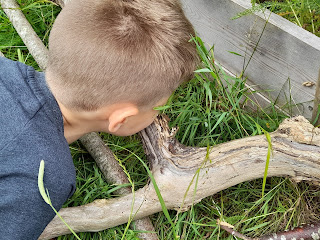It's Risky
Education is full of contradictions.
We want free thinkers but the curriculum is prescribed.
We want independent learners but everything has a planned outcome.
We want each child to be curious and engaged but every child has the same activity.
We want children to take risks but we remove almost all of them.
We want curious, independent, able, children who can self-regulate, behave responsibly, and think for themselves, yet nothing in the curriculum teaches them how to do this! It's written as a one-size-fits-all document and teachers try to weave their magic by opening it up as much as they can, making it as inclusive as possible, within the small time frame the termly schedule allows.
Long Term Event
Set in Nature
Holistic Approach
Learner centred
Risk Benefits
Qualified staff
These foundations in every practice will look different. For us, it looks like all Primary School Classes outside for a minimum of 90 minutes, for 6-week blocks, at least 3 times a year.
It takes place amongst trees, mud, grass, mud, wildlife, and more mud! And in rain, hail, snow, medium winds, sub-zero temperatures, and heat waves!
We do not teach a 'subject'. There are opportunities to learn everywhere and we highlight them. Children have the space to engage or disconnect with staff and peers, and a chance to connect with nature.
They can form big groups or small groups.
They choose or design their own activities.
They make new friends.
They spend time with established friends.
They choose to take time out alone.
The structure that makes this workable are a few Forest School 'rules' to make the space and exploration of it as safe as possible.
The implementation of it comes from a growing team of qualified staff. The support comes from staff accompanying classes outside with an open mind, ready to observe and encourage personal, social, and emotional development, as well as learning. The commitment to it comes from a Senior Leadership Team who value the opportunity to use our space and resources to support children’s wellbeing and the building of learning skills.
At the heart of it all is Risky Play.
To begin with, being outside is itself risky. Well, to be honest, so is inside! Being alive carries risks! At Forest School we focus on the hazards outdoors. From stinging nettles and prickly plants to icy patches and dirty puddles, just walking around our space usually carries a risk.
These are risks we don't want to remove.
These are risks that children learn to identify and navigate.
Larger risks, risks you choose to take, like how to climb a tree or how to use tools reinforce the importance of the rules.
These rules are repeated weekly, like a mantra! The children understand them.
The children are 'supervised', this can mean direct instruction on how to use a saw/peeler/penknife etc, or it can mean working independently alongside an adult.
Children are much better at assessing risks than we anticipate, and will never master risk assessment unless we let them take some risks!
The opportunity to explore 'alone', to venture into new areas or ever-changing familiar ones, challenges children to find markers in the landscape, to recognise some of their immediate environment regardless of season, and to plot their way around without getting lost!
Running, jumping, cart-wheeling, rolling... moving at speed aids perceptual development while climbing requires spatial awareness, and calculations of depth, size, shape, and distance. All of this involves muscle control and growing strength. It's an emotional release and a test of their own ability and stamina. Often it requires teamwork and cooperation too.
Muscles are also a necessity when using tools. Whether it's digging or sawing, hand-eye coordination is essential, and an understanding of how much force is needed to be successful is a skill in itself.
Building knowledge and understanding on how to do things that are dangerous, like being around a fire, sparking a flame for a campfire, using a knife to whittle, or avoiding falling into the pond, is the best way to learn how to be safe!
Understanding limits and boundaries is a life skill.
Technology rules 21st-century life. Schools cram a curriculum into a week around assemblies and playtimes and lunches, Parents often need to drop children off early, and/or pick them up later, and children's after-school activities are frequently structured lessons in swimming, dance, or sport. The freedom to just roam with friends choosing your own activities is fading fast.
Forest school is one of the very few regular opportunities for children to immerse themselves in nature, challenge themselves, and try something risky in a safe way!
The word RISK always conjures images of things gone wrong!
We take risks every day.
We get into our cars.
We cross the street.
We make a coffee.
We cook dinner...
We don't crash daily, get knocked over 10 times a month, scald our hands on every kettle, and set fire to the kitchen once a week!
We have 'rules' that help us navigate all these things safely, most of the time these things are routine and we don't think of them as risk management. They range from big mitigations like needing to pass a driving test to get into a car, and following instructions when using kitchen equipment to ensure nothing explodes!
Over the years we've learned to look when stepping into the road so automatically that we don't consciously remind ourselves to do so!
None of us were born knowing how to manage risk.
Children need to learn how to take risks.
It's the same as learning to be safe.











Comments
Post a Comment